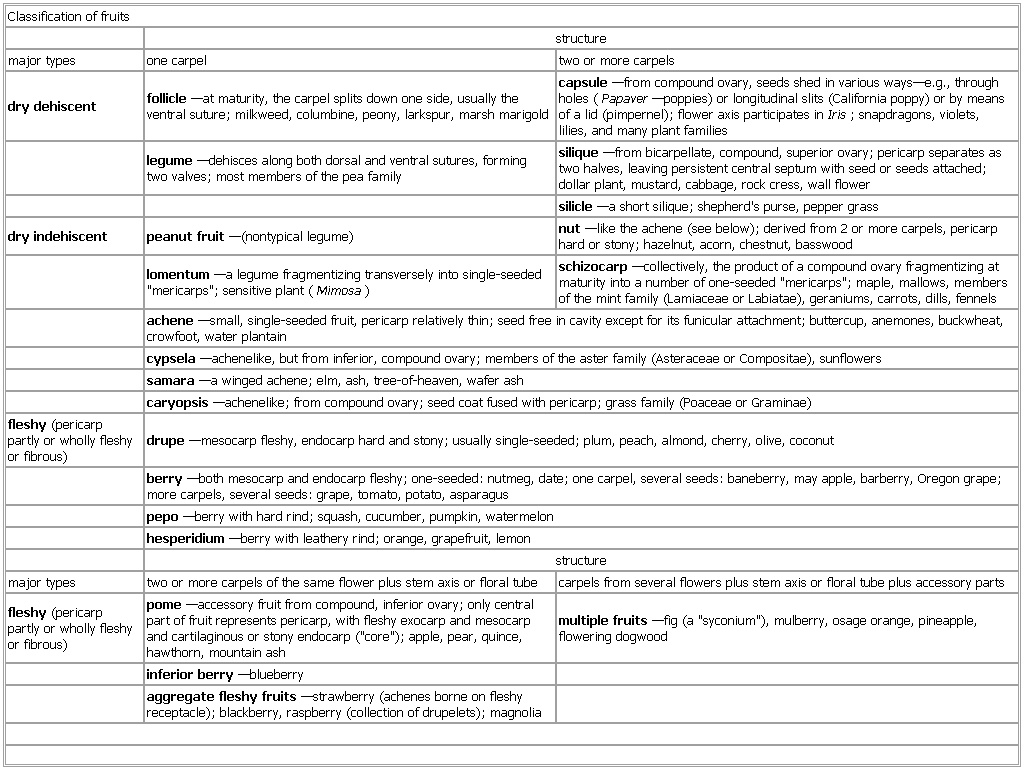- Classification of fruits
-
▪ TableClassification of fruitsstructuremajor types one carpel two or more carpelsdry dehiscent follicle—at maturity, the carpel splits down one side, usually the ventral suture; milkweed, columbine, peony, larkspur, marsh marigold capsule—from compound ovary, seeds shed in various ways—e.g., through holes (Papaver—poppies) or longitudinal slits (California poppy) or by means of a lid (pimpernel); flower axis participates in Iris; snapdragons, violets, lilies, and many plant familieslegume—dehisces along both dorsal and ventral sutures, forming two valves; most members of the pea family silique—from bicarpellate, compound, superior ovary; pericarp separates as two halves, leaving persistent central septum with seed or seeds attached; dollar plant, mustard, cabbage, rock cress, wall flowerdry indehiscent peanut fruit—(nontypical legume) nut—like the achene (see below); derived from 2 or more carpels, pericarp hard or stony; hazelnut, acorn, chestnut, basswoodlomentum—a legume fragmentizing transversely into single-seeded "mericarps"; sensitive plant (Mimosa) schizocarp—collectively, the product of a compound ovary fragmentizing at maturity into a number of one-seeded "mericarps"; maple, mallows, members of the mint family (Lamiaceae or Labiatae), geraniums, carrots, dills, fennelsachene—small, single-seeded fruit, pericarp relatively thin; seed free in cavity except for its funicular attachment; buttercup, anemones, buckwheat, crowfoot, water plantaincypsela—achenelike, but from inferior, compound ovary; members of the aster family (Asteraceae or Compositae), sunflowerscaryopsis—achenelike; from compound ovary; seed coat fused with pericarp; grass family (Poaceae or Graminae)fleshy (pericarp partly or wholly fleshy or fibrous) drupe—mesocarp fleshy, endocarp hard and stony; usually single-seeded; plum, peach, almond, cherry, olive, coconutberry—both mesocarp and endocarp fleshy; one-seeded: nutmeg, date; one carpel, several seeds: baneberry, may apple, barberry, Oregon grape; more carpels, several seeds: grape, tomato, potato, asparagusstructuremajor types two or more carpels of the same flower plus stem axis or floral tube carpels from several flowers plus stem axis or floral tube plus accessory partsfleshy (pericarp partly or wholly fleshy or fibrous) pome—accessory fruit from compound, inferior ovary; only central part of fruit represents pericarp, with fleshy exocarp and mesocarp and cartilaginous or stony endocarp ("core"); apple, pear, quince, hawthorn, mountain ash multiple fruits—fig (a "syconium"), mulberry, osage orange, pineapple, flowering dogwoodinferior berry—blueberryaggregate fleshy fruits—strawberry (achenes borne on fleshy receptacle); blackberry, raspberry (collection of drupelets); magnoliaSee as table:

* * *
Universalium. 2010.
